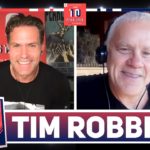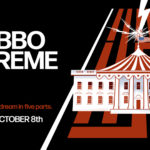By: Thomas Frey | March 2, 2020 | 10:51 AM

Noel Stack and Thomas Frey
Features editor and staff writer
The Actors’ Gang brings “The New Colossus” to Folsom’s Harris Center for the Arts, 10 College Parkway in Folsom, March 3 and 4 — a moving tribute to the nation of immigrants. The Mountain Democrat spoke with Academy Award winner Tim Robbins, director of the production and Actors’ Gang founding artistic director, about the production’s origins, why he likes having emotional roles and the power of hearing immigrants’ stories.
Question: Was there a reason you decided to perform this production at this time?
Answer: “We started it five years ago during the Syrian Refugee Crisis. We’ve been performing it off and on for a while.”
Q: What do you want the audience to talk about after the show and after the Q&A? What’s the topic you want on their minds?
A: “I want an audience to think whatever it wants to think. I don’t ever subscribe to the idea that I want an audience to think in one certain way. The great beauty of theater is that it creates dialogue. If you do your job well, it creates a vibrancy from a dialogue.
“Entertainment can be various things. Entertainment can be a prestige that distracts and makes everyone happy for a while and then everyone is happy after the show. That’s a legit thing to do but it’s not what The Actors’ Gang tends to do. We tend to do plays that resonate deeply with audience members, that tell stories … reflective of their own experience of the world that they are living in. There are their own concerns. Their own common emotional connections to stories have a lot to do with the way we present theater.
“At the end of the show I come out and I talk to the audience about where they are from and I ask people to start sharing their stories or their own ancestors’ stories, immigration or what it was like to be a refugee. We’ve heard some incredibly inspiring stories.
“The experience that happens after … we hear these stories, it kind of empowers the audience to think about their own ancestors. After people share, what happens in the lobby afterward is pretty cool because those who didn’t get a chance to share or were too shy to share around other people end up staying and talking about their relatives. I would say that we’ve been experiencing that pretty regularly.”
Q: How was it received when the idea was floating around before it actually became a production?
A: “I have a very diverse company in Los Angeles. Several actors for whom English is a second language, people who were immigrants or sons and daughters of immigrants. I had been looking to do a piece with them. We started talking when we saw what was happening with the Syrian Refugee Crisis and started asking ourselves what it is to be a refugee. Who are refugees? Who are we? What is our story?
“I encouraged 12 of the actors in the company to write either their own story or their ancestors’ story of immigration. What I found is that they all found a common story — a story of needing to get away from a dangerous situation in order to get a better life for themselves or their future generations.
“Another common story was what kind of courage it takes and what kind of strength it takes to survive that journey. We started to weave them together into a story — 12 different refugees from 12 different time periods speaking 12 different languages. The first time we did it, we saw immediately how deeply it resonated with the audience. It was only after two or three performances that we realized we really needed to talk to the audience because they were staying after the show and sharing their own experiences. Let’s make that part of the play. Let’s make the audience part of the play at the end. Really we are telling their story.”
Q: Have you traced back your ancestors’ story?
A: My grandfather did many years ago. John Robbins was the first Robbins to travel to America in 1640 in Connecticut. He died in 1660. His grave still exists.
“My mother’s family came a little bit later up through the South. They came from England and Ireland. They (lived in) Mississippi and Kentucky and up in Missouri. Both of my grandparents grew up in the West. My father’s family were homesteaders in Washington state. My mother’s mother is actually a different story of migration — a woman who was cultured, forward-thinking, independent. (She) played violin for a string quartet … had a family that she could no longer tolerate (because of) racism. Particularly a brother named Doug who was a flat-out bigot. She chose to leave and go to California.”
Q: In speaking with the audience, have you ever found a story so captivating that you wanted to weave it into your production or encourage them in some way to write it down?
A: “We have been hearing so many amazing stories. Here is what we are doing, we started in North Carolina and we have a bunch of cameras with us. Every night after we do our talk … and we hear some of these stories from the audience, we invite many audience members back who want to share their story and we have been filming them. So we have a whole backlog of them — incredible stories we are going to figure out how to share. I don’t know whether it will be part of a film version of ‘The New Colossus’ or whether we are going to do an independent project that’s a documentary that’s about immigration in America.
“Extraordinary stories. On two separate nights in North Carolina. Two separate stories, both in Italy, of women that were promised to men that they didn’t want to marry, they took the dowry and bought a boat ticket and came to the United States. Of course, the relative is telling it with great pride.
“Heard a story of this kid who tried to get legal migration, early 20th century, a boy who traveled alone. He had an address of his relatives pinned to his shirt (but officials) wouldn’t let him in so the kid jumps off the boat, swims to shore, hides out in horse stables … is homeless. Doesn’t have the address of his family anymore because it got wet in the water, has to survive on his own. He is 9 years old. Eventually, a family adopts him. That gentleman said it was his great-great uncle and he was one of the founders of Teamsters.
“Another story also of people who helped — a ship’s captain that came into Ellis Island and there was a quota, a per month quota that had already (been) exceeded. The ship got turned around. There were 10 days until the next month started and its quota would begin and the people at Ellis Island told (the captain) to take them back to their origin country. And the ship’s captain instead went out to sea, fed his passengers for 10 days, then first thing in the morning on the first of the month, he sails into New York Harbor — the very first boat of the month and gets everybody in.”
Q: Why is the production called “The New Colossus?”
A: “Well there is a poem called ‘The New Colossus’ by Emma Lazarus that is on the base of the Statue of Liberty. It’s a poem that I find deeply inspiring. The famous lines are ‘Give me your tired, your poor, your huddled masses yearning to breathe free.’ But the lines after that are equally strong. ‘The wretched refuse of your teeming shore. Send these, the homeless, tempest-tost to me, I lift my lamp beside the golden door.’
“In other words, we are a strong enough country to take people who are in trouble that need help, who are homeless, who are troubled, who need us. That kind of strength is what we possess in this country. Not only will we let them in but we will guide your safe passage with a light.
“That for me always represented what this country was about. It’s not like the hateful rhetoric of immigrants has started in the past few years. This has been around forever. Every single wave of migration was met with racism, with xenophobia, with hateful rhetoric. It’s a time-honored tradition of politicians since the beginning of time, divide and conquer. As long as people are fighting with each other they won’t notice how corrupt we are in the way that we run things. This device is nothing new. The Italians met it when they first came. The Irish need not apply. You should see some of these racist cartoons from the late 19th century about Italian and Irish immigrants. They were made into this kind of demonized race of people. That poem is for me, the counter balance to that hateful rhetoric.”
Q: Do you find that sometimes the discussion after the performance turns to this immigration issue or do people generally stick to their stories?
A: “Last night we had a guy say to us that there was a guy he knew that was just arrested by ICE and is being held in detention. We’ve heard stories of illegal detentions; we’ve heard stories of moving where they are incarcerating people. Two nights ago we heard a story of a father being ripped away from his children, his children crying in the street. It does come up in discussion because people have a vested interest in it.
“We don’t tell people what to say and we don’t censor anybody. People are willing to stand in front of other people and testify and I’m all for that. That is what a free and open society should be about. We have had nobody that has stood up and defended what is happening right now. That might be pretty telling.”
Q: Are there challenges in balancing a career in movies and television while also serving as the artistic director for The Actors’ Gang?
A: “It’s challenging to run a nonprofit for sure. It’s a difficult thing. Trying to maintain an organization that does an immense amount of volunteer work, getting funding for that.
“We are currently in 13 state prisons running 15 yards. We have rehabilitation programs; The Actor’s Gang has been doing this for 12 years. We’ve managed to figure out a pretty effective rehabilitation — 89% reduction in prison infractions for people who have been through our program.
“We also run educational programs in 12 Los Angeles area schools — elementary, middle and high school. We do after-school programs.
“We do reentry programs for formerly incarcerated people who are entering society. We do work in the juvenile detention centers and we produce anywhere from four to eight shows per year plus touring. It is quite challenging balancing all of that with a career in Hollywood.
“But I have found that throughout the years, it’s been 38 years now, the thing that has kept me most grounded and centered and focused and growing as an artist has been The Actors’ Gang. It’s a great lesson in humility to be able to walk into a theater and either perform for or direct for a live audience. You can’t cheat that. They are going to tell you how they feel by their reaction at the moment. Oftentimes in Hollywood, you can get in a little bubble, a self-congratulatory bubble. The only reaction you hear is from people you’re paying to represent you and that can be unhealthy sometimes.”
Q: Is there a particular reason that you have had a career drawn to emotional roles and emotional films and emotional theater?
A: “I haven’t done a comedy for a while but I love doing them. I’ve done some cameos in ‘Austin Powers’ and ‘Anchorman’ and those types of movies. So I like doing them. I enjoy comedy. I like satire. I like telling stories that resonate with people — that move people.
“The great thing about theater and movies, as well, is you get people in a room and they have an opportunity and this is particularly true in theater. You have an opportunity to create a live moment with a new audience every night. Every night is going to be a different chemistry. At that moment you can create a community. You can create a shared emotion. In other words, people can laugh together or they can cry together; they can be angry together. They can pop into a collective fear and they can share that regardless of their politics or their points of view or who they are or where they are from.
“In these times in such a decisiveness, it is such a gift to have a theater and a theater company where we can travel around and create a common experience for people — a common shared emotion. That is something that unites people. After uniting them through emotion, to then speak with them and share their stories, it’s something that I feel very thrilled by right now.”


